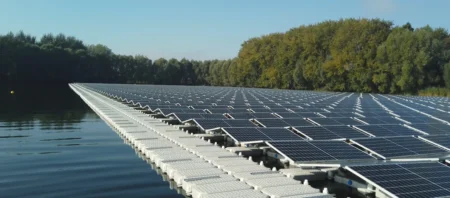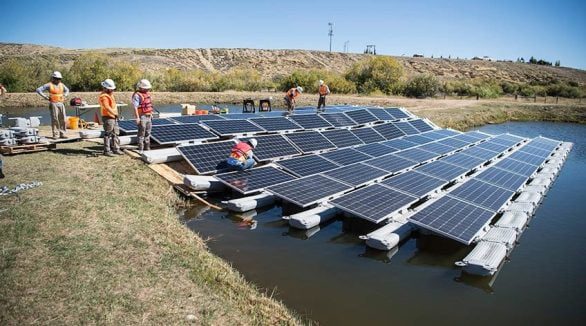Fluidized Bed Reactor Technology Stakes Its Claim in Solar Polysilicon Manufacturing.
El Segundo, Calif. (May 7, 2014)—Despite challenges related to purity and efficiency, low-cost Fluidized Bed Reactor (FBR) manufacturing technology is expected to make significant gains in the market for solar polysilicon during the next few years, according to a new report from IHS Technology (NYSE: IHS).
Sponsors

Sponsors

Sponsors

This year the FBR process will account for nearly 10.0 percent of the production of global photovoltaic (PV) polysilicon, which represents the first step in PV module manufacturing leading to the creation of solar panels. However, the next few years will see FBR gradually take share away from the technology that now dominates the market: the Siemens process.
By 2020, FBR will account for 16.7 percent of the market, as shown in the attached table. This compares to 77.9 percent for the Siemens process, with the remaining 5.4 percent of the market represented by a third technology, known as upgraded metallurgical grade (UMG).
“The PV market is optimistic about demand in the foreseeable future, and starting with polysilicon production, major manufacturers are increasing capital spending and expanding production operations to position themselves to capitalize on the growth,” said Jon-Frederick Campos, analyst for solar research at IHS.
To this end, polysilicon producer REC Silicon recently announced a 19,000-metric ton (MT) expansion in capacity, of which 18,000 MT will utilize FBR technology, along with 1,000MT of Siemens-based capacity, said Campos.
Chinese-based GCL-Poly and SunEdison have also gone on record to announce that they are also building polysilicon plants using FBR technology.
These findings can be found in the report, PV Manufacturing Technology Report – World 2014, from the Power & Energy service of IHS.
Benefits and pitfalls
FBR is a third-generation solar technology that is able to effectively control granules that might cause pollution during the purification process. In FBR, monosilane is injected into the bottom of the reactor to form a fluidized bed that carries silicon seed particles fed from above. Silicon deposits from the monosilane on the seed particles until they have grown to larger granules, which can then be withdrawn from the reactor continuously.
Contrary to a batch process, fewer resources are wasted in FBR, and less setup and downtime is required. FBR needs only 10 percent of the electricity consumed by a conventional rod reactor in the established Siemens process, as it does not waste energy by placing heated gas and silicon in contact with cold surfaces.
“FBR takes less energy, shortens crucible fill times and produces more silicon per cubic meter of reactor space, as the crystals have a larger total surface area than the rods used in the Siemens process,” Campos noted. “FBR presents many benefits of high interest for polysilicon producers, with advocates for the technology saying that FBR can produce output at a cash cost of $10 per kilogram in the foreseeable future—a sizable decrease in cost versus the $14 per kilogram promised by its best-in-class Siemens counterparts.”
However, experts agree that there are two fundamental inhibitors to the promise of FBR. First, there are questions on whether the technology can reach the industry demand for silicon purity close to, or at, electronic-grade level given cash costs of less than $10 per kilogram.
A second concern relates to scalability. The deposition in a fluidized bed reactor is not easy to control as dynamics change with size, and reactors cannot simply be scaled up from pilot to industrial scale.
To be sure, it will be more difficult for FBR to make a stronger business case than the Siemens process, even if cost is important to polysilicon manufacturers. This is because the purity of silicon is becoming a larger factor in the improvement of PV energy outputs.
“Cell manufacturers are requiring higher-quality polysilicon to meet their efficiency road maps, such that the lower material costs and potential for improved margins presented by FBR along with other polysilicon technologies are overshadowed by industry standards having shifted toward higher-purity polysilicon, namely 9N and above, because higher-purity polysilicon can boost solar cell efficiencies,” Campos said.
The Siemens technology is capable of meeting these needs by producing polysilicon at purity levels at or above 9N to 11N, Campos remarked. In comparison, FBR outputs at 6N to 9N, while UMG produces at approximately 5N to 6N.
As the PV industry continues to mature, demand from solar-cell manufacturers will dictate the direction of the market in the future for polysilicon. The industry in all likelihood will continue to strongly favor the Siemens process, IHS believes, although time will tell if FBR can combine cost savings with higher purity outputs to tilt the equation.
For FBR and UMG, the tangible benefits provided by their cost benefits will keep these technologies alive in the minds of polysilicon module producers. At the same time, the higher-quality polysilicon delivered by the Siemens process will continue to undermine these same cost savings from FBR and their kin, unless the younger technologies are able to foster higher-purity outputs.
About IHS (www.ihs.com)
IHS (NYSE: IHS) is the leading source of information, insight and analytics in critical areas that shape today’s business landscape. Businesses and governments in more than 165 countries around the globe rely on the comprehensive content, expert independent analysis and flexible delivery methods of IHS to make high-impact decisions and develop strategies with speed and confidence. IHS has been in business since 1959 and became a publicly traded company on the New York Stock Exchange in 2005. Headquartered in Englewood, Colorado, USA, IHS is committed to sustainable, profitable growth and employs more than 8,000 people in 31 countries around the world.
Share your industry press now!
Are you a PR agency or sustainability-focused organization? Join the World of Renewables network FREE today and gain exclusive access to our platform to promote your business, share the latest industry news, and connect with a global audience of 700,000+ renewable energy professionals.
Register Now to start posting your updates and showcase your expertise to a highly engaged, environmentally-conscious community.
Find out more about our Content Partnership Programs.
*2024 AWARD WINNER* Websites & Mobile Sites, Webby Winner, Peoples Voice 2024














